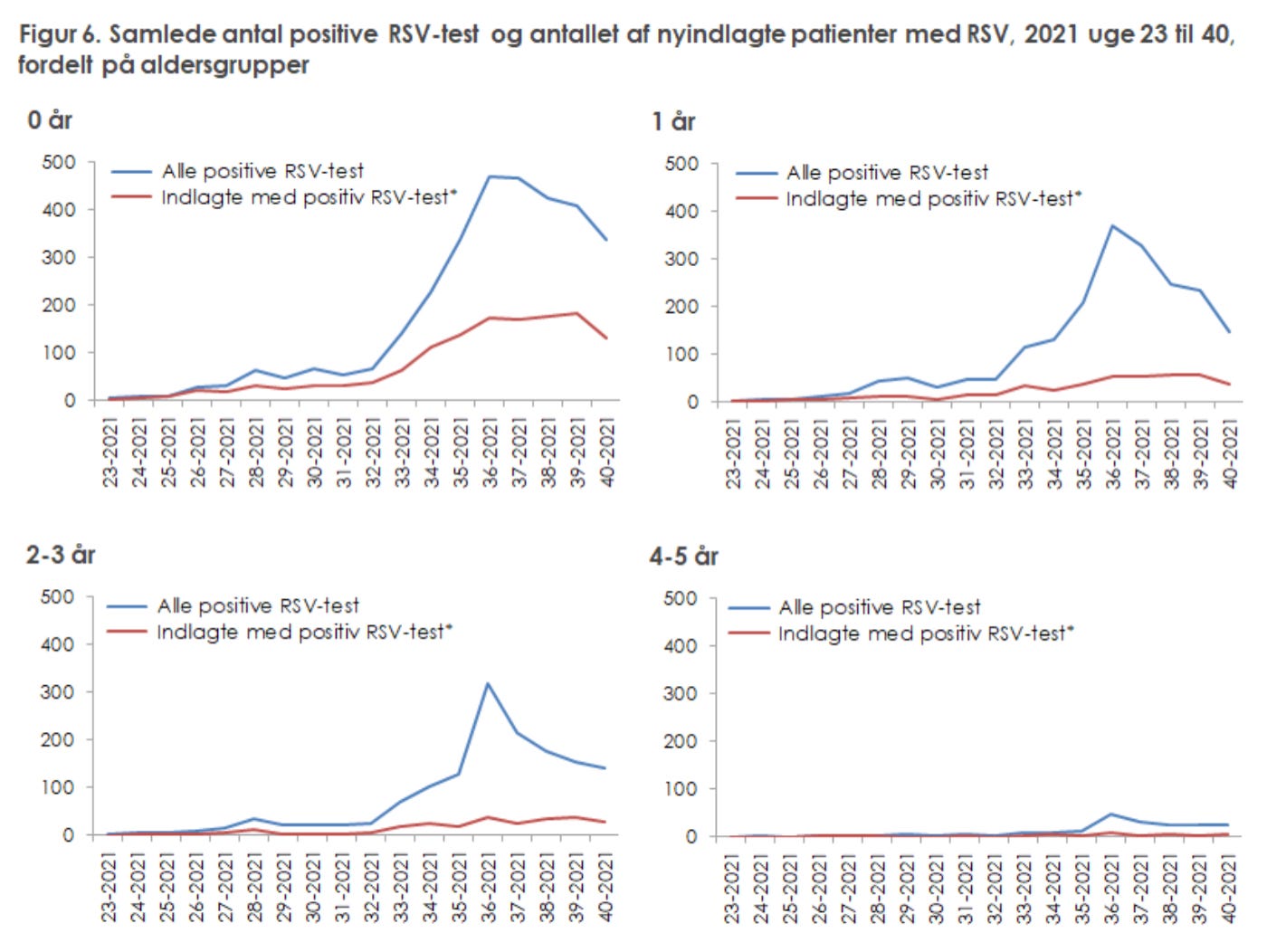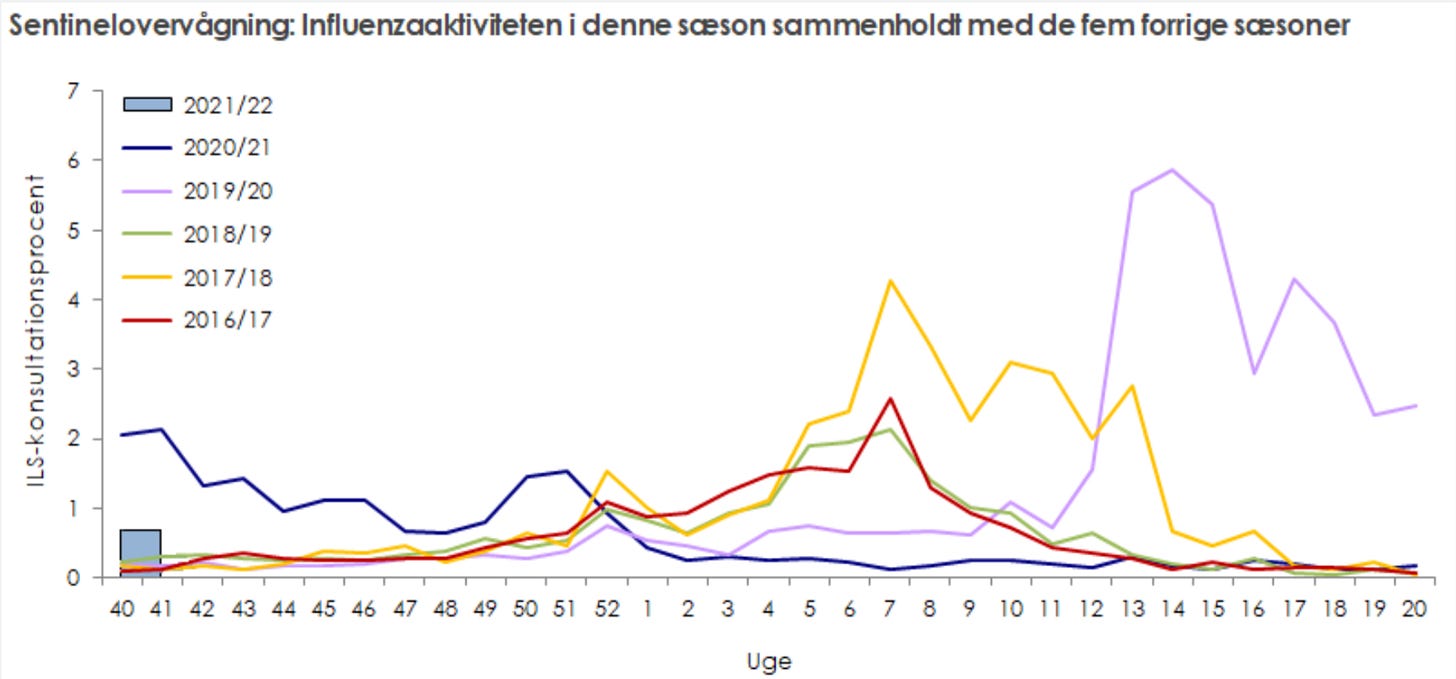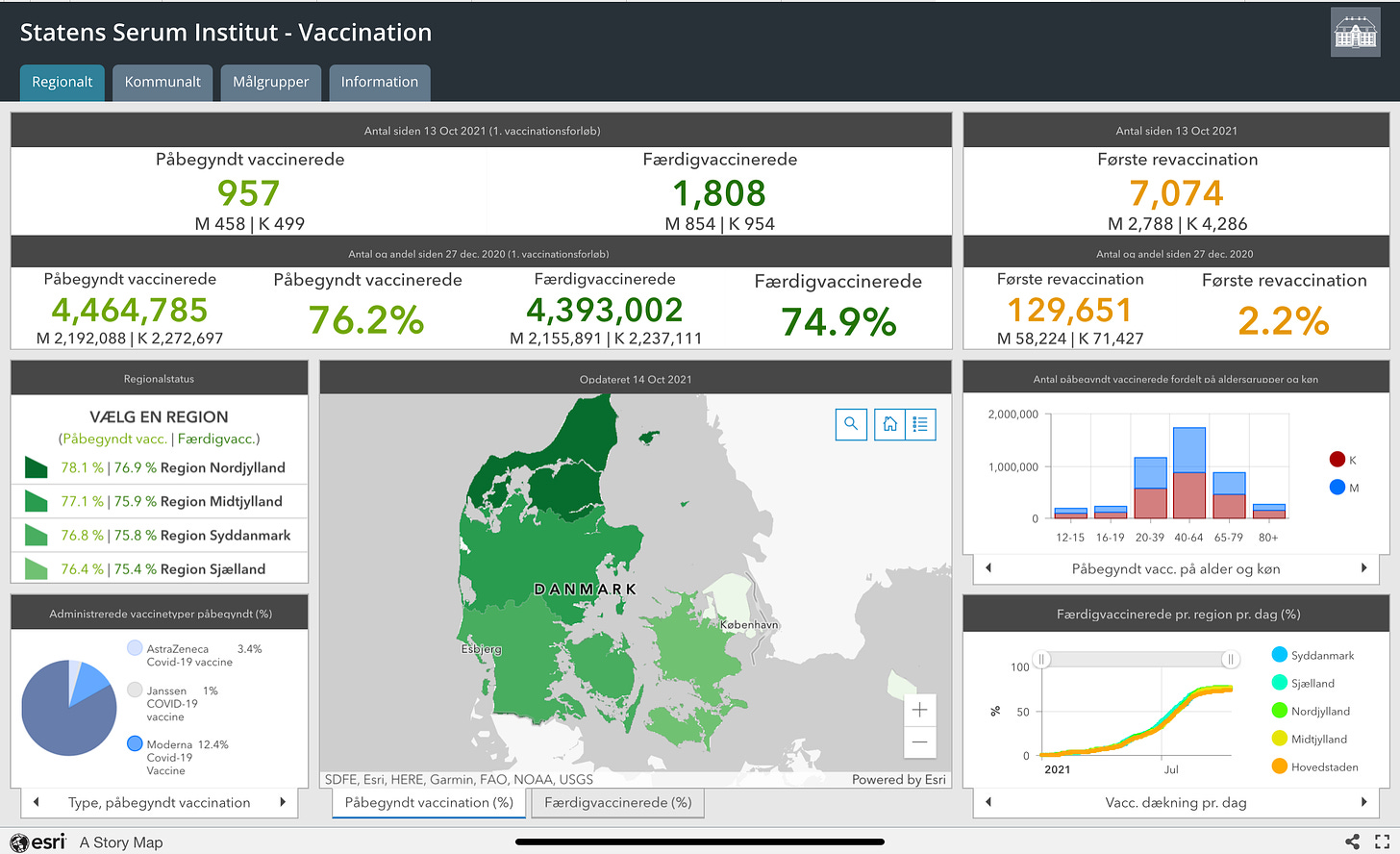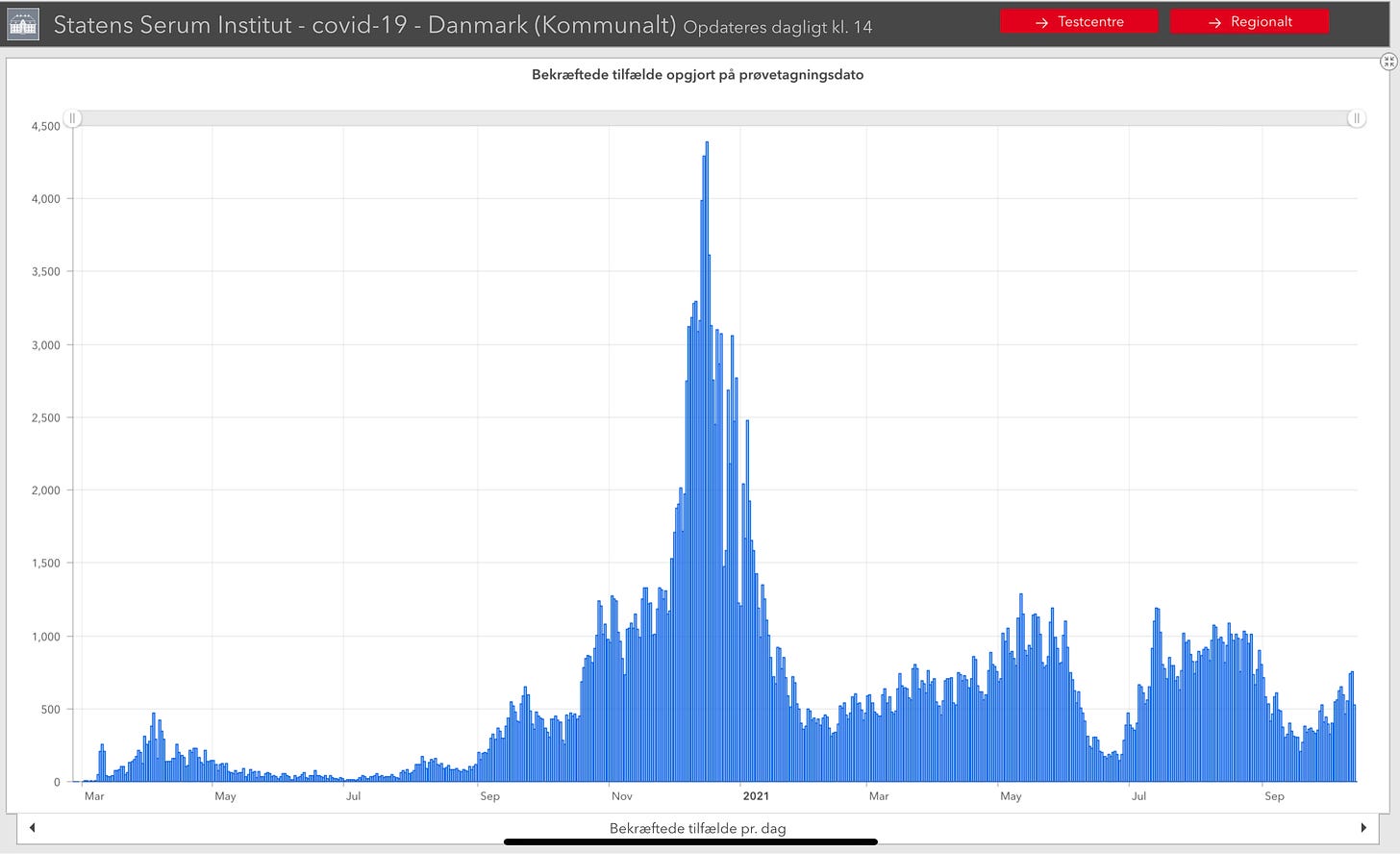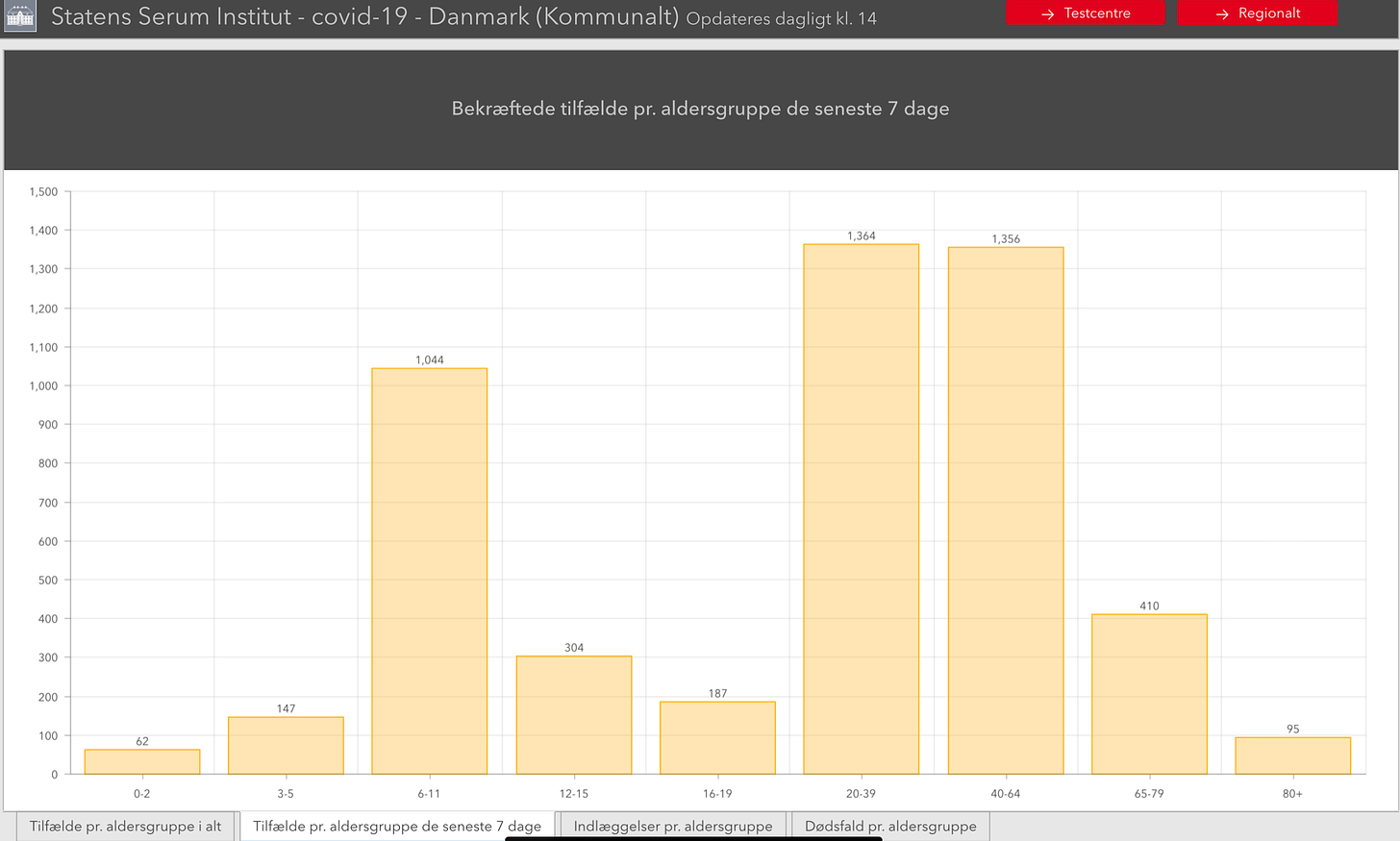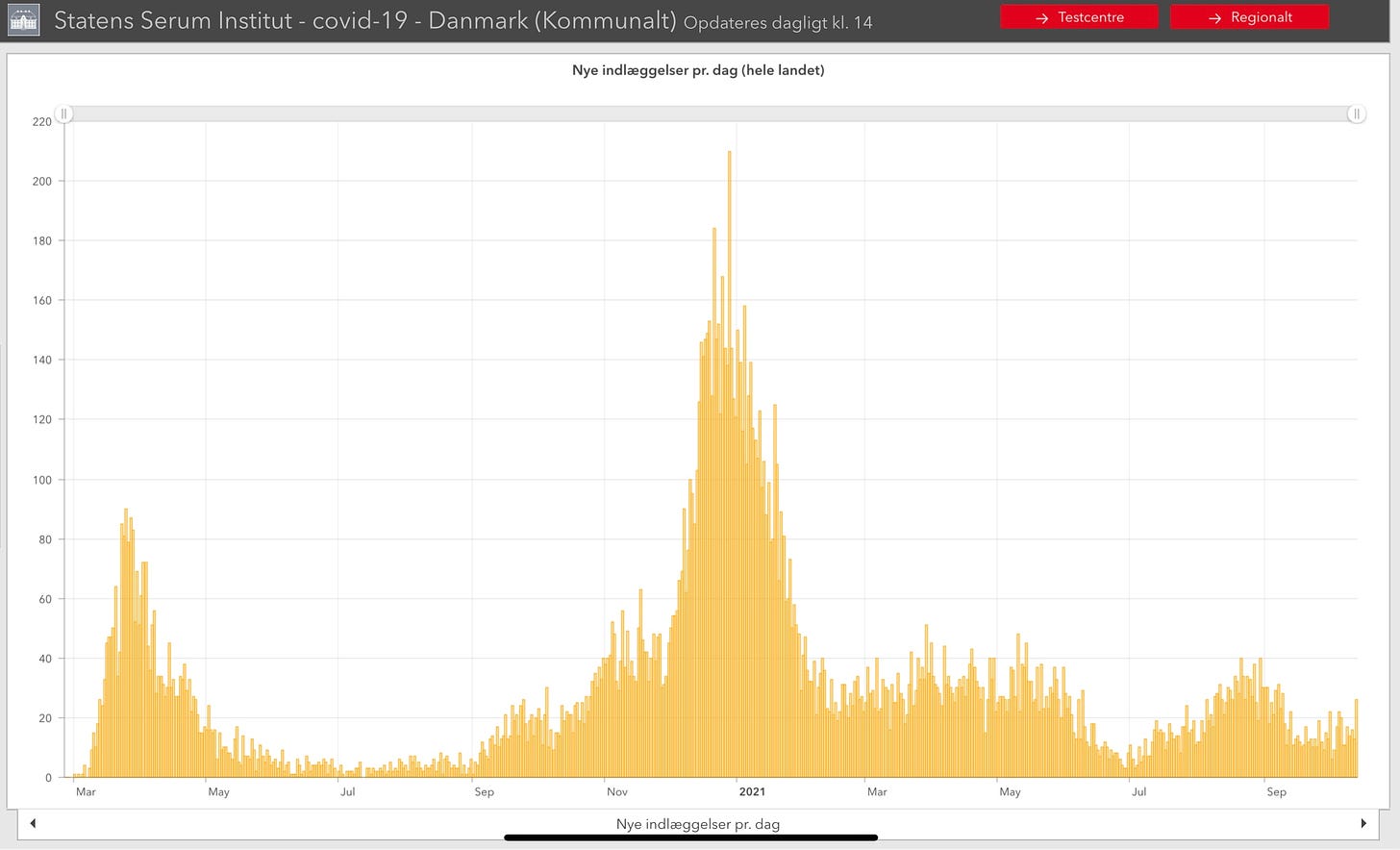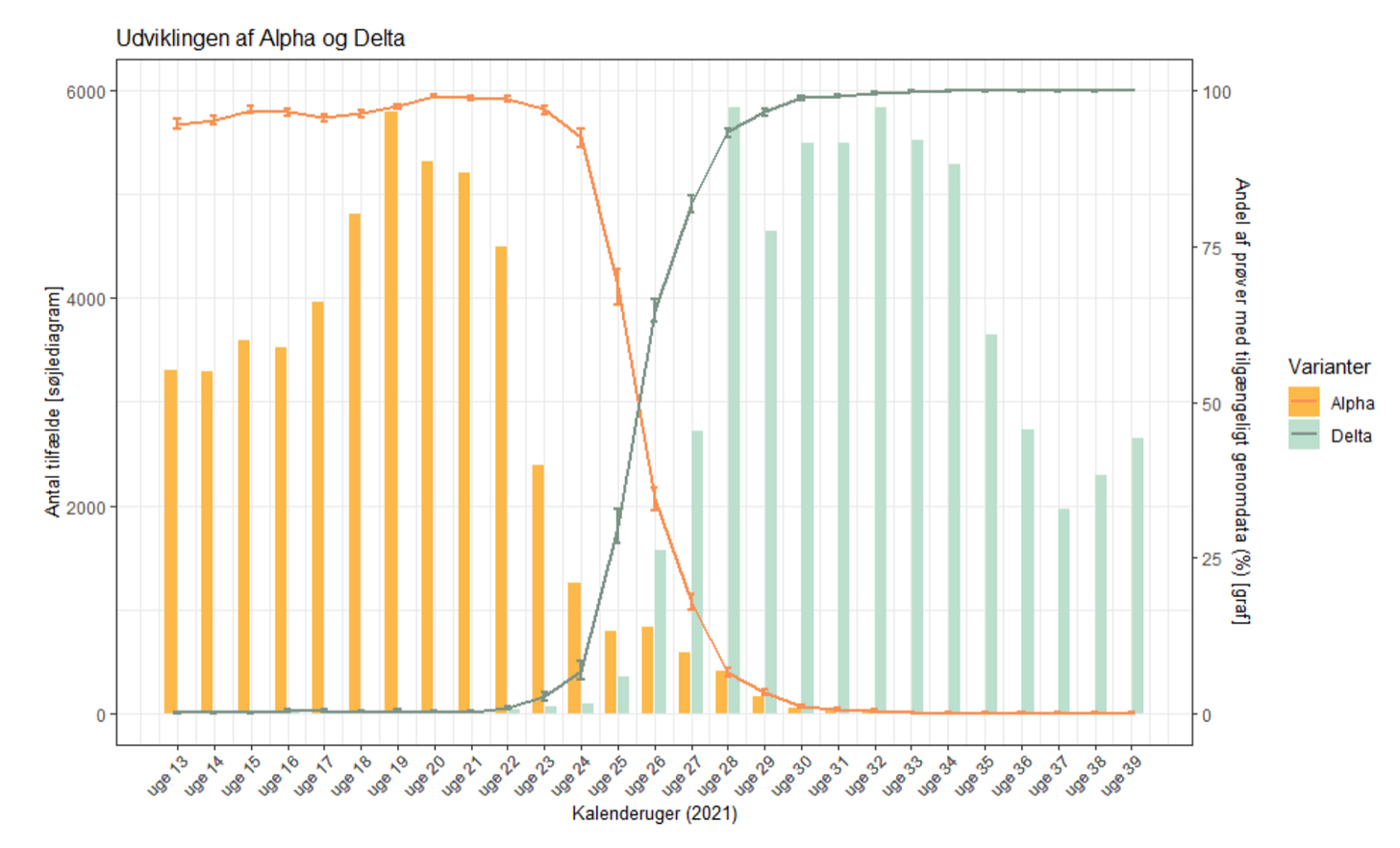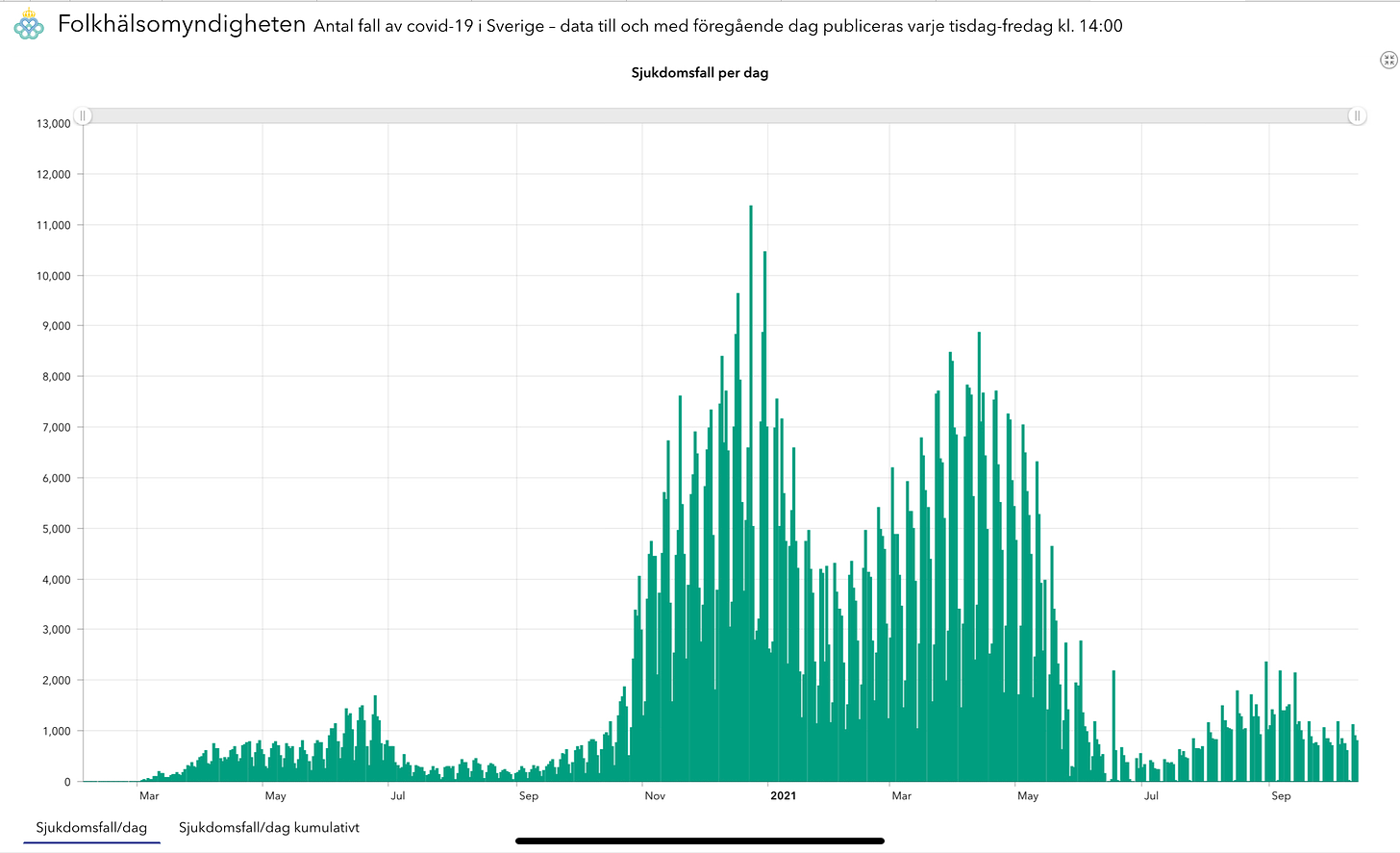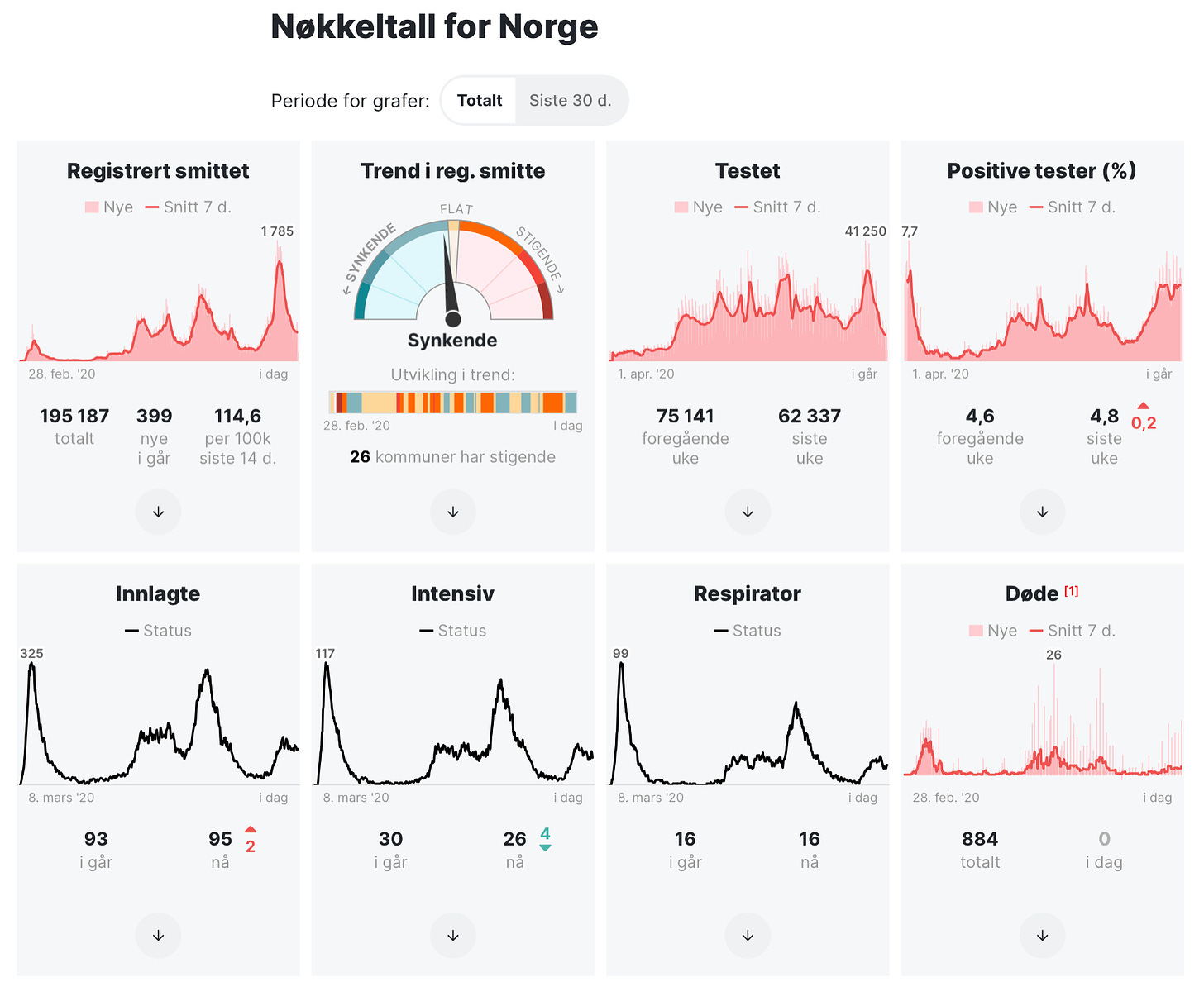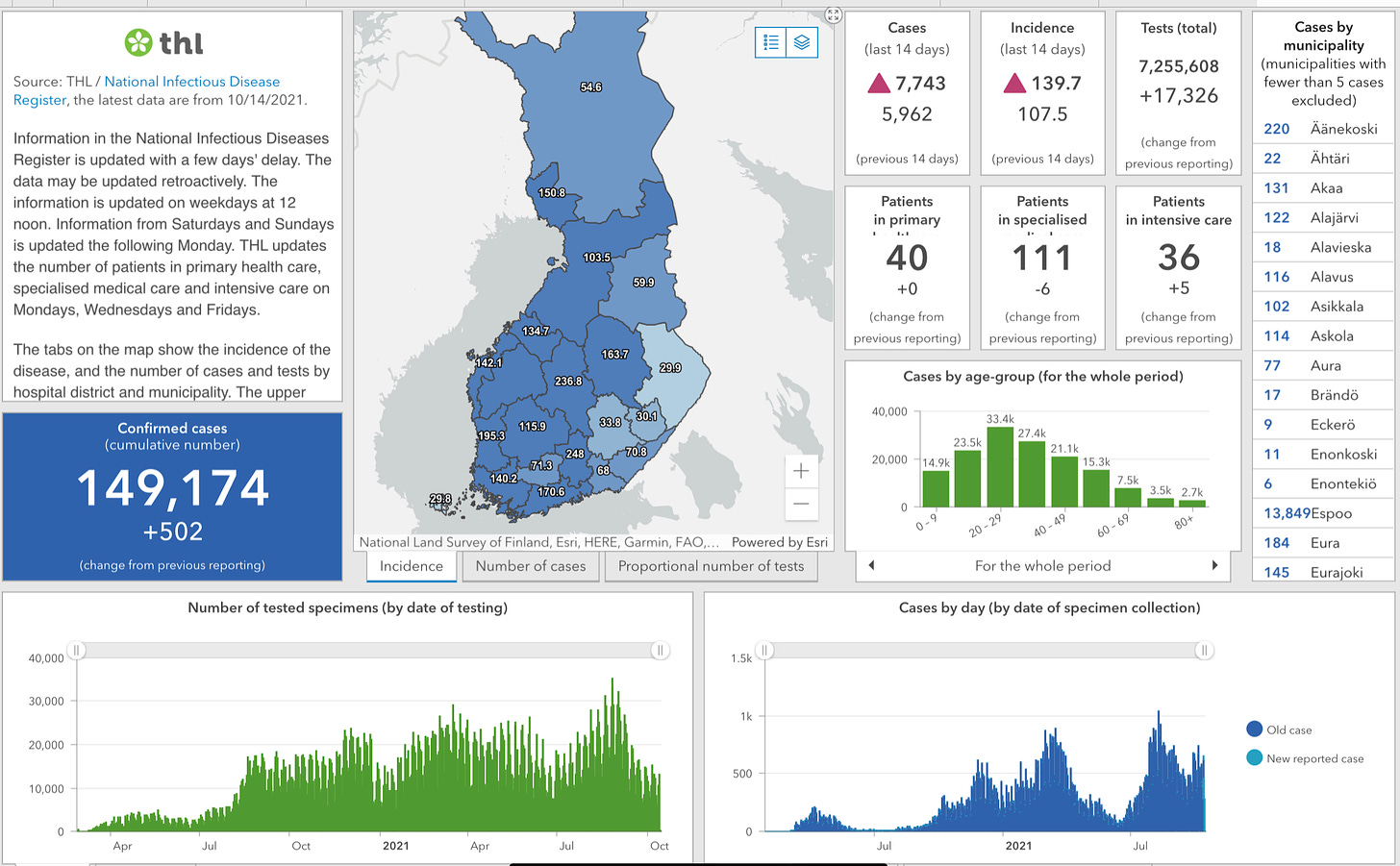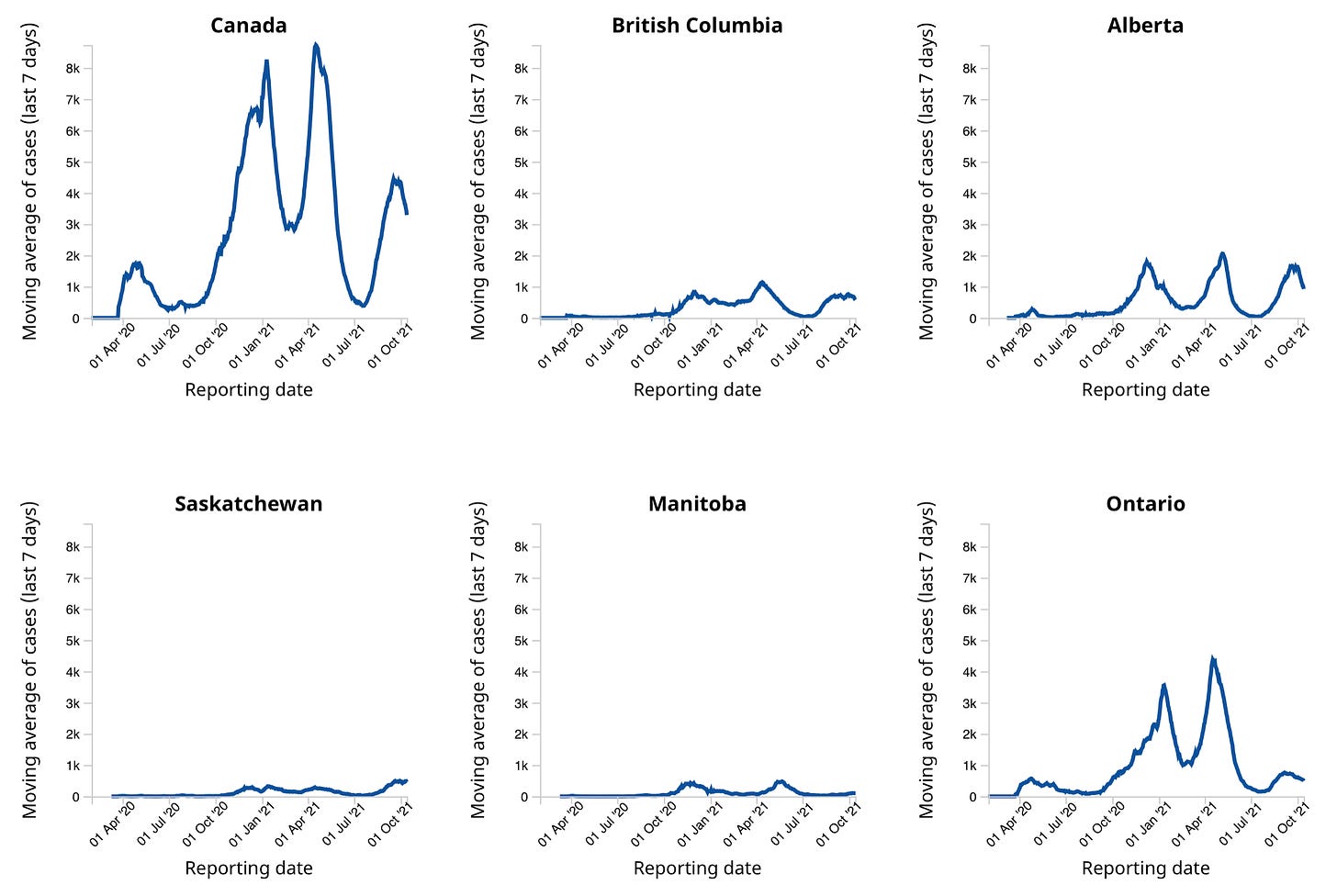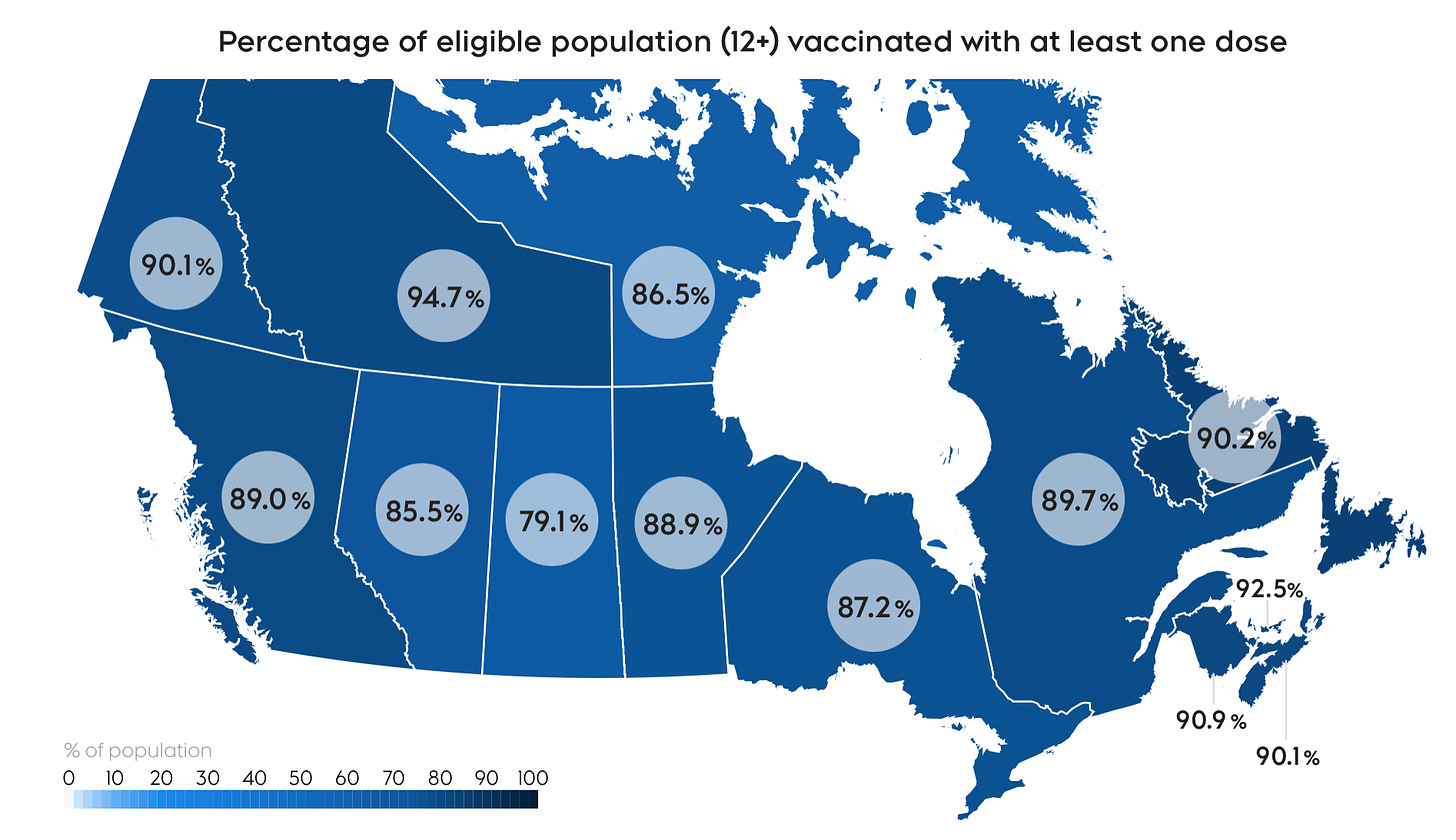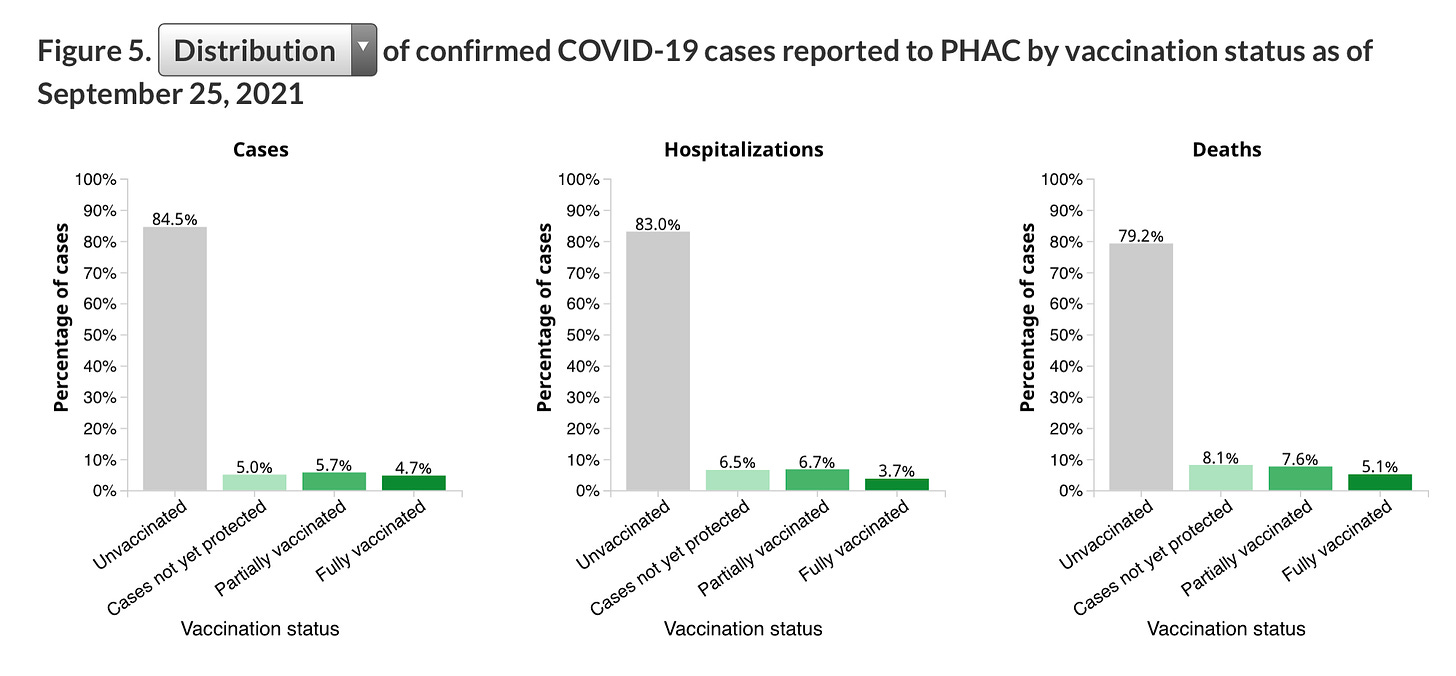🇩🇰
The RS virus infection wave seems to be easing, although, according to the Staten Serum Institut virus numbers are still much higher than they have ever been before. Last week there were 848 confirmed infections pushing to date totals to 8,844 cases since week 20. The RS virus positivity percentage last week was 34.9%, which is extremely high. The SSI says this indicates that “a very widespread RS virus transmission continues.”
Below is an Institut graphs tracking RS virus hospitalizations among the four youngest age groups.
The SSI says RS virus rates remain about three to four times higher than anything ever seen before in Denmark. The virus usually arrives in the winter and peaks in February. This year it has shown up much earlier than ever before, and in numbers much higher than ever before.
-
As of last week, the Staten Serum Institut has activated its influenza surveillance measures. It has now published its first week of data. So far, seasonal influenza numbers are at a low level, with just six positive test results out of 4,003 people tested. Two tested positive for Influenza A and the other four for the B strain.
Denmark has begun a major flu shot campaign with more than 500,000 people inoculated so far. Approximately 1.3 million influenza vaccine doses have been delivered out of the 2.5 million on order. At the moment, priority groups are first in line including children, healthcare workers, and seniors. The vaccination program should open to everyone else in the last week of October.
-
On the vaccination front so far, 76.2% of the total population has one vaccine dose and 74.9% are fully vaccinated. A further 2.2% have had a booster shot.
Wednesday, there were 9,839 total inoculations done, of which just 957 were 1st doses.
-
Denmark is reporting 767 COVID infections and two more coronavirus deaths in the last day. Wednesday, there were 789 infections, the highest daily number since August 31.
Wednesday, there were 74,865 total corona tests done and of those 56,271 were PCR tests equaling a positivity percentage of 1.36%.
While infection numbers rise again, at least one expert is shrugging it off. Doctor and Associate Professor at Aarhus University Hospital, Christian Wejse, told DR there is no cause for concern. Wejse says infection numbers are not the best metric to measure the COVID situation anymore. He says hospitalization numbers are much more important and right now they remain under 100. As for infection activity, he says it will continue to mount.
“With the number of patients we have now, it is not a big problem. But we can probably get used to the idea that infection rates will continue to rise. The fact is that the increase right now is seasonal. It is fall and winter is coming, and we are therefore spending more time indoors. There we can more easily infect each other.”
-
A concerning level of infection activity among children aged 6 to 11 years old is continuing across Denmark. In the last seven days, coronavirus infections among that age group have reached 1,044, by far the most among any other group 19 years old and younger.
However, hospitalization stats over the same seven days show that there have been no hospital admissions for anyone 11 years old or younger. For the 12 to 19 year old age group, there have been just four total hospital admissions in the last week.
-
COVID hospitalizations (90) have inched downward (-1) while the number of infected people in an ICU (16) also edged down (-2) and of those the number on a ventilator (10) also dipped slightly (-1).
-
The Delta variant remains absolutely dominant in Denmark as it has driven its predecessor, the Alpha variant, into non-existence in Denmark. For a ninth week in a row, the Delta variant is the only variant of concern that has been detected among all sequenced positive results.
-
Denmark has donated 250,000 doses of the Johnson & Johnson vaccine to Rwanda. The donation has been made outside the international COVAX initiative. According to Development Aid Ministry “vaccines that are in national warehouses cannot in principle be donated through the international vaccine collaboration.” It says Rwanda has a desperate need and has shown an ability to quickly and efficiently get vaccinations done.
Minister Flemming Møller Mortensen:
“It is a global responsibility to ensure increased vaccine access, and here Denmark shows that we take responsibility and show solidarity. The donation is a natural extension of our increased relations with Rwanda and the MoUs (Memorandum of Understandings) that were concluded in the spring.”
Apparently a “number of legal and practical matters” still need to be sorted out before the doses can be shipped.
Denmark has previously donated 358,700 vaccine doses to Kenya and another one-million doses to the COVAX initiative. Statsminister Mette Frederiksen recently announced an additional two-million doses will go to the COVAX program, with the vaccines earmarked for 12 African countries.
🇩🇰 🇸🇪 🇳🇴 🇫🇮 ✈️
According to Ritzau, several airlines will drop the requirement to wear a face mask while flying as of Monday. Among them are SAS and Norwegian airlines, according to the report. However, only people flying “domestically or across the Scandinavian countries” will be able to forgo having to wear a mask. The mandate remains in place for other airlines and all international travel outside the Nordic bubble.
🇸🇪
Sweden has added 799 infections and another four corona deaths since yesterday’s update.
So far, 7,205,874 1st vaccine doses (84.4% of the population 16 years old and older) and 6,779,383 2nd vaccine doses (79.4%) have been administered.
-
The Swedish Public Health Agency is changing its testing strategy, saying fully vaccinated people no longer need to get tested even if they are symptomatic. The advice for people with both doses, which also applies to everyone else, will be to stay home if you feel sick. The official change in recommendations will come into force on November 1.
As of November 1 for those fully vaccinated, anyone with a recent infection, and children under 6 years old:
To go to work or school you must not have any symptoms.
Anyone who has symptoms should stay home from work or school.
To return to school, daycare, work, and any other activities, a person must have not had a fever in the previous 24 hours.
Assistant State Epidemiologist Karin Tegmark Wisell:
“For most people, this means that you could be at home for at least a couple of days, but more likely up to a week. But COVID testing is not recommended for this group.”
For the unvaccinated:
Anyone with symptoms should get tested.
Anyone with symptoms should stay home.
To return to work or school, an unvaccinated person must have been fever free for the previous 24 hours and have a negative COVID test.
Sweden’s national health agency says overall infection activity has so far not shown any upward trend since all COVID restrictions were lifted on September 29. But it is warning that does not mean the pandemic is over.
“We estimate that there will be minor outbreaks, and especially among the unvaccinated, and therefore it is important to continue testing if you belong to a group for which it is recommended.”
Nationally, the infection situation in Sweden has been stable for two weeks now, although some regions have seen higher numbers.
🇳🇴
Norway has added 912 infections and had 13 more virus deaths in the last two days.
COVID hospitalizations (95) have edged upward (+2) while the number of infected people in an ICU (26) has gone down (-4) and of those the number on a ventilator (16) is unchanged.
To date, 77.70% of Norwegians 12 years old and older have had one vaccine dose and 68.65% have had both doses.
-
In its latest weekly COVID situational assessment, the Norwegian Institute of Public Health says hospital admissions have been slowly declining over the last three weeks. There were 53 hospitalizations last week, with 60 the week before and 61 the week before that. Last week, 57% of infection cases being admitted to hospital were unvaccinated.
On the infection activity front, overall cases have declined for a fifth straight week. Last week saw a 14% decrease from the week prior. The institute is also reporting a “sharp decrease” in infections among people under the age of 20. The overall COVID incidence rate last week in Norway was about five times higher for those who were unvaccinated compared to those who were.
The NIPH is cautioning, though, that the outlook ahead is uncertain. It is advising health authorities to brace for more infection activity and more hospitalizations due to the seasonal effect. It also warns “other respiratory infections” could also complicate things.
🇫🇮
Finland has registered 502 infections and nine more deaths since Wednesday’s update.
COVID hospitalizations (187) have increased again (+7).
-
The number of hospitalizations in Finland continues to rise. The Finnish Institute for Health says in the last four weeks the number of new COVID admissions each week has risen from 60 to 109 patients. The last two weeks have each seen 22 new ICU admissions.
The institute says for the number of hospital admissions to go down, more people need to get vaccinated and the overall number of daily infections must also be reduced. It says for an unvaccinated person the risk of hospitalization and death due to COVID is much higher than those who have had both doses. In the last two weeks, the agency says, unvaccinated 12 to 79 year olds have been hospitalized at 19 times the rate of vaccinated people in the same age group. It is also seeing ICU admissions for unvaccinated 50 to 79 year olds at 24 times the number of fully vaccinated people of the same age.
If there is a glimmer of potential good news as Finland’s numbers climb, it is that wastewater testing, often a very accurate pandemic barometer, is seeing lower levels of COVID activity.
🌏🦠
The World Health Organization is taking one last stab at an investigation into the origins of the coronavirus pandemic. A new research team has been created to investigate, among other things, COVID activity in Wuhan, China, where the pandemic began. It will also try to figure out whether the virus jumped from animals to humans in Wuhan’s wet markets or whether the virus came from a laboratory near the city. Both possible origins have been the basis for tonnes of speculation.
WHO Crisis Manager Mike Ryan:
“This is our best chance, and it may be our last chance to understand how this virus originated.”
China has already issued veiled warnings saying it hopes the committee is not politically manipulated in its work and in any conclusions. Previous WHO efforts to investigate COVID origins in China were stymied.
-
For the first time in over a decade, tuberculosis deaths around the world have increased. The World Health Organization blames the coronavirus pandemic, saying it has undone years of global progress in curtailing tuberculosis. The WHO says in 2020 far fewer people were diagnosed while conversely, tuberculosis claimed more lives. It says with the focus shifting to the COVID pandemic and the subsequent lockdowns, it prevented people from seeking help, getting diagnosed, and receiving treatment. Further, the pandemic has shifted funding and attention away from TB treatments and care delivery, further exacerbating the problem.
WHO Director General Tedros Adhanom Ghebreyesus:
“This report confirms our fears that the disruption of essential health services due to the pandemic could start to unravel years of progress against tuberculosis. This is alarming news that must serve as a global wake-up call to the urgent need for investments and innovation to close the gaps in diagnosis, treatment and care for the millions of people affected by this ancient but preventable and treatable disease.”
The WHO is warning that 2020 may not be an outlier and the world could see even higher tuberculosis deaths this year and next.
In 2020, there were approximately 1.5 million tuberculosis fatalities, according to the World Health Organization. It says the deaths were concentrated mostly among 30 countries who suffer the highest prevalence of TB cases.
🇺🇸 💉
The United States has donated 17 million doses of the Johnson & Johnson one-shot COVID vaccine to Africa. The continent has had abysmal vaccination rates so far, with fewer than 5% of people across Africa fully vaccinated against the coronavirus.
🇨🇦
We are finally getting a look at how Canada fared since its update prior to the Thanksgiving day long weekend. On Saturday and Sunday it saw just over 3,500 newly infected each day. Since Monday it has seen over 2,000 new daily COVID cases, including 2,659 infections reported on Thursday. In the last five days there have been another 181 lives lost to the virus.
Nationally and among most of the provinces, the infection curve seems to be trending downward.
The Canadian vaccination effort has administered 29,396,065 1st doses (76.88% of the total population) and 27,558,196 people (72.07%) are now fully vaccinated.
As of September 25 (Public Health Canada numbers tend to lag behind) the bulk of new COVID cases, hospitalizations, and deaths are among people who are not vaccinated.
In Ontario on Wednesday and Thursday, there were a combined 723 infections, and of those 473 were among people who were either not fully vaccinated or who had one dose. There are 254 people in hospital, of which 223 are either not vaccinated or not fully vaccinated. Of the 158 people in an ICU that number is 145.
Quebec reported 644 infections and two deaths Thursday. The day before, it saw 512 infections and another seven fatalities. As of November 1, all bars and restaurants in the province can return to full capacity.
In Atlantic Canada, For the sixth time in the last two weeks, and the sixth time ever, New Brunswick reported over 100 new infections on Thursday. There were 133. On Wednesday, all health care facilities in the province were put back on COVID ‘red’ protocols to deal with surging admissions. Nova Scotia had 26 new cases. Newfoundland and Labrador had four.
Manitoba saw 107 infections Thursday and another 79 the day before. There have been no new deaths.
On Wednesday and Thursday, there were a combined 642 infections and 16 more corona deaths in Saskatchewan.
Alberta logged 916 infections and 30 corona deaths Thursday. On Wednesday, it saw 652 cases and another 38 fatalities. There are 1,016 people in hospital and 231 in an ICU. The province has a positivity percentage of 7.5%. Chief Medical Health Officer Dr. Deena Hinshaw is apologizing to the family of a 14-year-old after mistakenly reporting the death as COVID related on Tuesday.
B.C. registered 580 infections and another nine deaths on Thursday. The day before it had 605 infections and four more deaths. There are 374 people in hospital with 153 in an ICU. Health Minister Adrian Dix says 90% of those in intensive care are unvaccinated.




